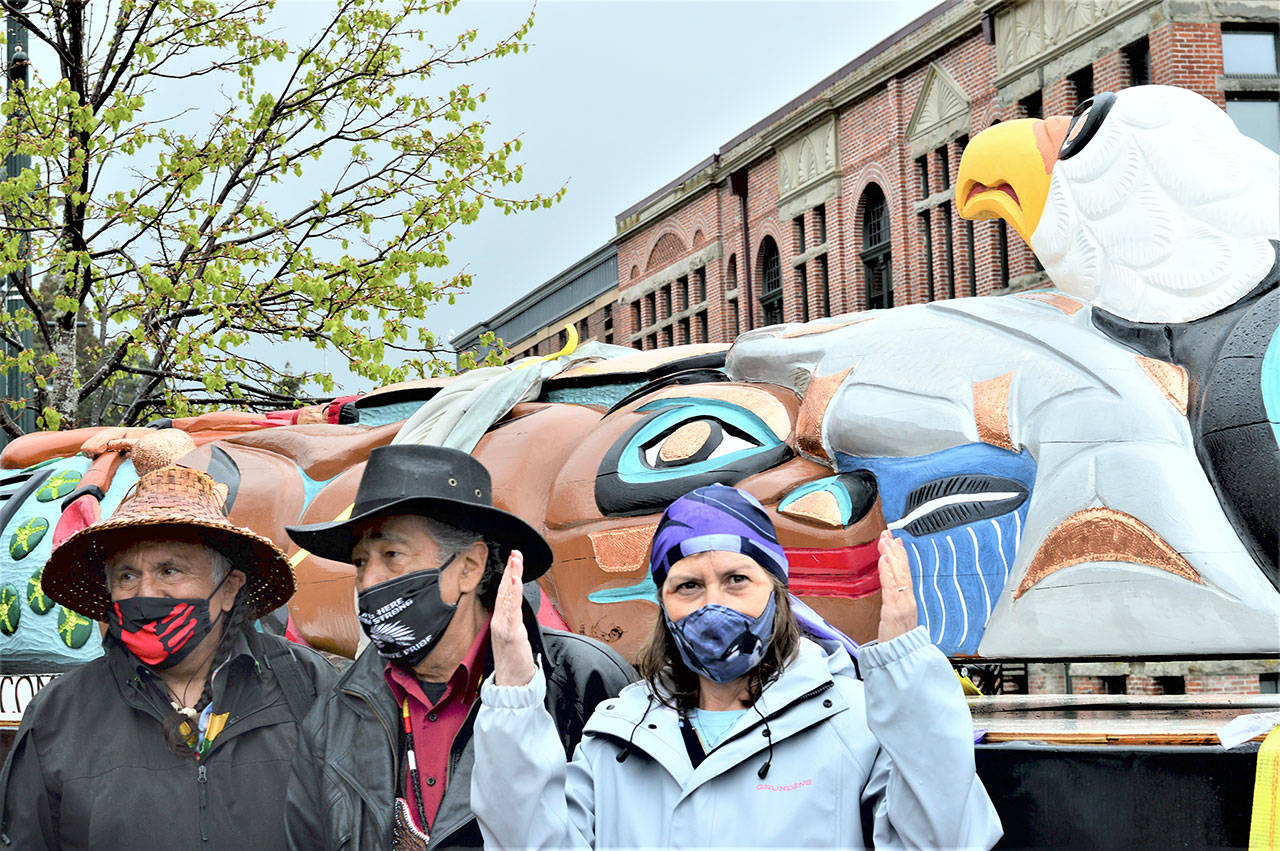PORT TOWNSEND — In a steady rain Saturday, some 150 people gathered in downtown Port Townsend to surround a guest with their blessings.
A 24-foot, 8-inch cedar totem pole from the Lummi Nation arrived at Pope Marine Park at 10:30 a.m., lying on a long flatbed truck, a carved bald eagle gazing skyward.
Accompanying the pole were main carver Jewell James, known to his Lummi tribe as Se Sealth, and his older brother Douglas James, known as Sit ki kadem. Douglas’ wife Siam’elwit stood beside the two men, raising her hands to the crowd in an expression of hyshqe: thank you.
The totem pole, which will travel to Washington, D.C.’s National Museum of the American Indian this summer, made a kind of debut in Port Townsend. Just finished at the Lummi House of Tears carving shed outside Bellingham, it has begun a Northwest tour first.
“It definitely catches the eye,” Douglas said of the pole’s trip on the Edmonds-Kingston ferry Saturday.
Tribal members from across and beyond the North Olympic Peninsula greeted their Lummi cousins, singing songs and raising their hands. The North Olympic Peninsula Broadband of the Great Old Broads for Wilderness, the event’s primary sponsor, also welcomed the carvers, as did the North Olympic Orca Pod and several elected officials.
“I feel a little presumptuous welcoming you to your lands,” said Port Townsend Mayor Michelle Sandoval.
“Thank you for being our teachers,” she added.
Calling attention to the pole’s carving of a caged child — which Jewell had explained represents the children held at the U.S.-Mexico border — Sandoval added that her people come from Mexico.
“I too am horrified by what’s going on at that border,” she said.
Yet Sandoval has hope because “for the first time, we have a Native woman as Secretary of the Interior,” in Deb Haaland, the Laguna Pueblo tribal member appointed to President Joe Biden’s cabinet.
Freddie Lane, road manager and documentary filmmaker for the totem pole’s journey, said it will, in early August, be presented to the Biden administration “for honoring the first American Indian to serve in the cabinet.”
With its images of animals, river water, two women and a child, the pole was carved also to raise awareness about Earth’s sacred places. Among them is the Lower Snake River, where tribes and other environmental advocates seek to remove the four dams that have severely inhibited salmon migration.
Jefferson County Commissioner Heidi Eisenhour, who grew up on a salmon fishing boat, spoke at Saturday’s welcoming ceremony, reminding the crowd of the Board of Commissioners’ letter to U.S. Rep. Derek Kilmer calling for removal of the Lower Snake dams.
These keystone fish have sustained her family and this community, Eisenhour said.
“Imagine if, in our lifetimes,” she added, “we worked toward the return of the salmon to the Snake River.”
Kate Lore, minister at the Quimper Unitarian Universalist Fellowship — whose Native Connections and Green Sanctuary action groups cosponsored Saturday’s event — led a blessing that rose up loud around the totem pole.
“May it bring wisdom, strength and courage to all who view it,” she called out.
The pole will be a kind of traveling exhibition, Lane told its visitors on Saturday. From Port Townsend it will tour the Northwest and the West Coast; departure for the nation’s capital is set for mid-July. Stops will include Bear’s Ears National Monument in Utah, Chaco Canyon in New Mexico, White Earth, Minn., and Standing Rock in North Dakota.
After its arrival in Washington, D.C., “the final raising of the pole has yet to be determined,” Lane said.
The theme of the trek is “Our Shared Responsibility,” as in the need to protect and restore this country’s precious lands and waters.
In a video Lane produced with Jewell, the carver explains the pole’s symbols. The river water, he says, is the blood of the Earth. And the pole bears another form of water: images of seven tears, for seven generations of trauma.
“I’ve been fortunate to have a couple of visionary dreams” during his time carving this pole, he adds.
Our trauma is not finished, Jewell says of his carving of the caged boy: “This is a Mexican child, an indigenous child, reaching out for someone to help.
“Those are our people, those little children.”
________
Jefferson County senior reporter Diane Urbani de la Paz can be reached at 360-417-3509 or durbanidelapaz@peninsuladailynews.com.

